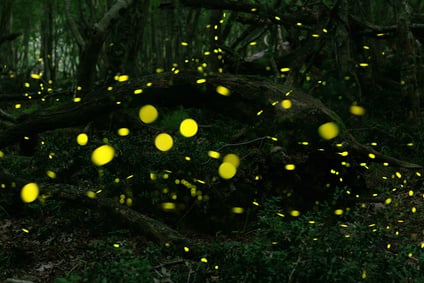Think You Know Fireflies? Think Again!
Rare synchronous fireflies can't be found in your backyard, but you can see them at Congaree National Park May 20-June 10

We've all taken delight at the magical fireflies that begin to appear in early summer. Synchronous fireflies are a rare phenomenon and can only be seen in a handful of places throughout the south.
Their proper name is Photinus carolinus and the short window of activity for these fascinating creatures is mid-May to mid-June.
During this time, the fireflies “flash” as part of a mating ritual. Scroll down for more about the mating ritual, which may provide you with an opportunity to have "the talk" with your kids.
Firefly Festival
Two of the four places they can be seen in the East are in our two nearest national parks: the Great Smoky Mountain National Park and Congaree National Park. As it happens, the lottery window has passed for a chance to see them at Great Smoky Mountains, but you don't need to win the lottery to see them at Congaree, barely 2 hours' drive from Charlotte.
The Harry Hampton Visitor Center at Congaree will be open until 9:00 pm from May 20 through June 10 as part of firefly season. Park staff will be available during the evenings to provide information and assist those that want to experience this wonder of nature.
As a culmination of the season, the park will host a Firefly Festival on Saturday, May 27. The special event will feature special programs, exhibits, and activities.
The Birds, Bees, and Fireflies
Synchronous firefly season might be a launching pad for "the talk" that some parents struggle to bring up without blushing. Here's the basics (per Wikipedia):
"The timing of flashing depends somewhat on temperature, but the flash pattern of a male Photinus carolinus is typically four to eight very bright flashes emitted over two to four seconds, followed by a dark period of eight to 12 seconds. The female reply is much less bright, a pulsed signal during the dark period of the male.
"Scientists have suggested one reason for the synchronized flashing is to create a synchronized dark period, during which males can search for female responses without being distracted by signals from other males.
"When males of Photinus carolinus detect a female response, a cluster of males will form surrounding the female, with as many as 20 males energetically walking, flashing, and attempting to mount the female or nearby males.
The female does not necessarily mate with the first male to reach her, but may show avoidance behaviors to several males before permitting one to begin copulation. In the early stages of copulation, other males may try to separate the couple, but once the mating pair has moved to stage 2 copulation (tail-to-tail), the unmated males fly off to seek females elsewhere."
If you to to Congaree, be sure to tag us in your social media updates!









